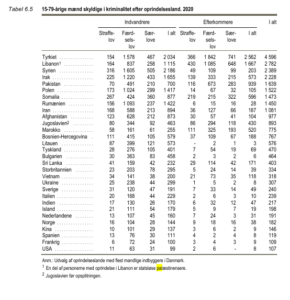What lies behind the staggering statistics about Palestinian refugees in Denmark? This page uncovers the socio-political factors shaping their integration and challenges.
From Peter Kofod, former Danish MEP stating that 64% of Palestinians refugees in Denmark now had a criminal record:
https://www.youtube.com/watch?v=mYQ9ggO6Lhk&t=2s
I emailed him to ascertain the source of this information and he sent me a link to this Danish government report:
https://www.dst.dk/Site/Dst/Udgivelser/GetPubFile.aspx?id=34714&sid=indv2021
Translated extracts:
The document provides detailed statistical information about immigrants and their descendants in Denmark, focusing on demographics, employment, education, income, poverty, and crime. Below is a summarized translation of key sections into English for consultation:
Immigrants in Denmark 2021
Published by Statistics Denmark December 2021 ISBN: 978-87-501-2390-3 ISSN: 1902-8954
Contact Information: Statistics Denmark Sejrøgade 11 2100 Copenhagen Ø Phone: +45 39 17 39 17 Email: dst@dst.dk Website: www.dst.dk
Summary
- Population Composition: Immigrants and their descendants make up 14% of Denmark’s population as of January 1, 2021. Immigrants account for 11%, with 58% originating from non-Western countries.
- Regional Distribution: Immigrants and descendants are concentrated in urban areas, with Region Hovedstaden having the highest proportion (20%).
- Birth Statistics: In 2020, 22% of newborns had mothers with immigrant or descendant backgrounds.
- Employment: Employment rates among non-Western immigrants remain lower than those of Western immigrants and individuals of Danish origin.
- Education: Non-Western descendants have lower rates of vocational education compared to individuals of Danish origin.
- Relative Poverty: Non-Western immigrant children are overrepresented among families living in relative poverty.
Definitions
- Immigrants: Individuals born abroad whose parents are not both Danish citizens born in Denmark.
- Descendants: Individuals born in Denmark whose parents are not both Danish citizens born in Denmark.
- Danish Origin: Individuals with at least one parent who is both a Danish citizen and born in Denmark.
Employment
- Employment Trends: Employment among non-Western immigrants increased significantly from 1995 to 2008 but declined during the financial crisis.
- Gender Disparities: Non-Western immigrant women have the lowest employment rates.
- MENAP+T Group: Immigrants from MENAP+T countries have lower employment rates compared to other groups.
Education
- Higher Education: Western immigrants have a higher proportion of individuals with long higher education degrees compared to individuals of Danish origin.
- School Performance: Students of Danish origin achieve higher grades in primary school exams compared to non-Western descendants.
Income, Inequality, and Wealth
- Income Before Tax: Non-Western immigrants have significantly lower incomes compared to Danish-origin individuals.
- Relative Poverty: 19% of non-Western immigrants live in relative poverty, compared to 3% of Danish-origin individuals.
Public Benefits
- Public Assistance: 38% of non-Western immigrants aged 16-64 receive public benefits, compared to 29% of Danish-origin individuals.
Crime
- Crime Rates: Crime rates are higher among non-Western immigrants and descendants compared to individuals of Danish origin.
- Crime by Origin: Male descendants from countries like Somalia, Syria, and Morocco have the highest crime indices, while male immigrants from countries like France, China, and India have the lowest.
This translation provides an overview of the document’s key findings and statistics. For detailed tables, figures, and additional context, the original document should be consulted.
Male Lebanese descendants, a large proportion of whom are descendants of stateless Palestinians, had the highest crime index at 376. The index is standardized by age. Male descendants originating in Somalia, Syria and Morocco also had an index above 300
Page 10:
An index that standardizes by age shows that crime in 2020 was 51 per cent higher among male immigrants and 149 per cent. higher among male descendants of non-Western backgrounds than among the entire male population. If there further standardized for the family’s level of education, the crime rate was 31 per cent respectively. and 108 per cent higher.
Male Lebanese descendants, a large proportion of whom are descendants of stateless persons Palestinians, with 376, had the highest crime index. The index is standardized by age. Male descendants originating in Somalia, Syria and Morocco also had an index above 300. The lowest crime index had male immigrants originating in France, China, USA and India. Their index was between 56 and 61 per cent. below the average for all men.
Page 117
Male Lebanese descendants, some of whom are descendants of stateless Palestinians, with 376 have the highest crime index among the countries studied when standardized for age. Male descendants with origins in Somalia, Syria and Morocco also have an index above 300. The lowest crime rate has male immigrants originating in France, China, the United States and India. Their index is between 56 per cent. And 61 per cent below the average for all men.
Page 121
If you look at people with origins other than Danish, Turkey is both for men and women the country from which the largest number of criminals come. This is of course connected to the fact that Turkey is the country with the most immigrants and descendants
have origins in. For the men, it is then Lebanon, Syria and Iraq, in which most criminals originate, and for the women, it is Lebanon and Poland. It should be mentioned,
that part of the people originating in Lebanon are stateless Palestinians.

Page 125
Men of Lebanese origin have the highest crime rates. It applies to both for immigrants with an index of 279 and for descendants with an index of 376. That it should be noted that people originating in Lebanon for a large part are stateless Palestinians. The exact share is not known, but it is estimated to be 50-60 percent However, stateless Palestinians will also be able to appear with origins in countries other than Lebanon.

Employment rates – Table 2.5Income levels – Table 4.2
On benefits – Table 5.5
Crime Regardless of origin, there are more men than women who have been convicted of crimes. Crime rates are generally highest for individuals under 40 years old. Particularly high is the proportion among 20-24-year-old men, where 2% have been convicted of violations of the penal code, 6% for traffic violations, and 4% have been convicted for violations of special laws in 2020. Non-Western immigrants and their descendants are younger than individuals of Danish origin. This is a factor that should be taken into account when comparing crime between different groups. An index that standardizes for age shows that crime in 2020 is 51% higher among male immigrants and 149% higher among male descendants with a non-Western background compared to the entire male population. Other factors such as relation to the labour market, the family's level of education, and the family's income can also influence crime rates. For instance, if the family’s level of education is included in the standardization, crime for the two groups reduces to being 31% and 108% higher, respectively. Male Lebanese descendants, some of whom are descendants of stateless Palestinians, have the highest crime index at 376 among the countries studied when standardized for age. Male descendants with origins in Somalia, Syria, and Morocco also have an index above 300. The lowest crime rates are found among male immigrants from France, China, the USA, and India. Their index is between 56% and 61% below the average for all men. Among men born in 1987, 16% had received one or more convictions for violations of the penal code before they turned 23. The proportion was highest for immigrants from non-Western countries, where 37% had been convicted before turning 23. For descendants from non-Western countries, the proportion was 33%, and for men of Danish origin, it was 15%. For men born ten years later in 1997 of Danish origin, there had been almost a halving in the proportion with a conviction as 22-year-olds. For male immigrants and descendants from non-Western countries, the proportions had fallen to 22% and 23%, respectively.
15-79-year-old men guilty of crime by country of origin. 2020 – Table 6.5




